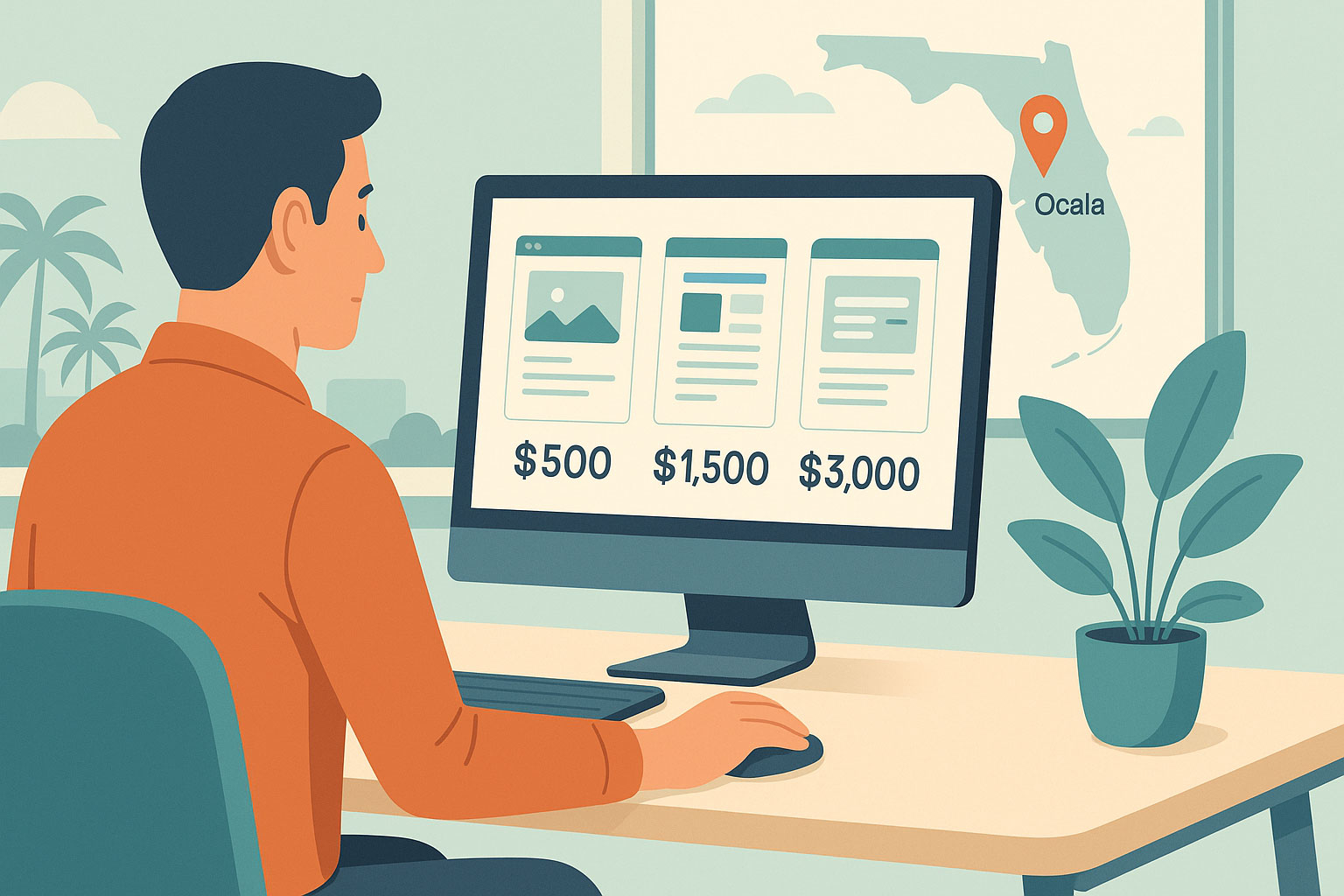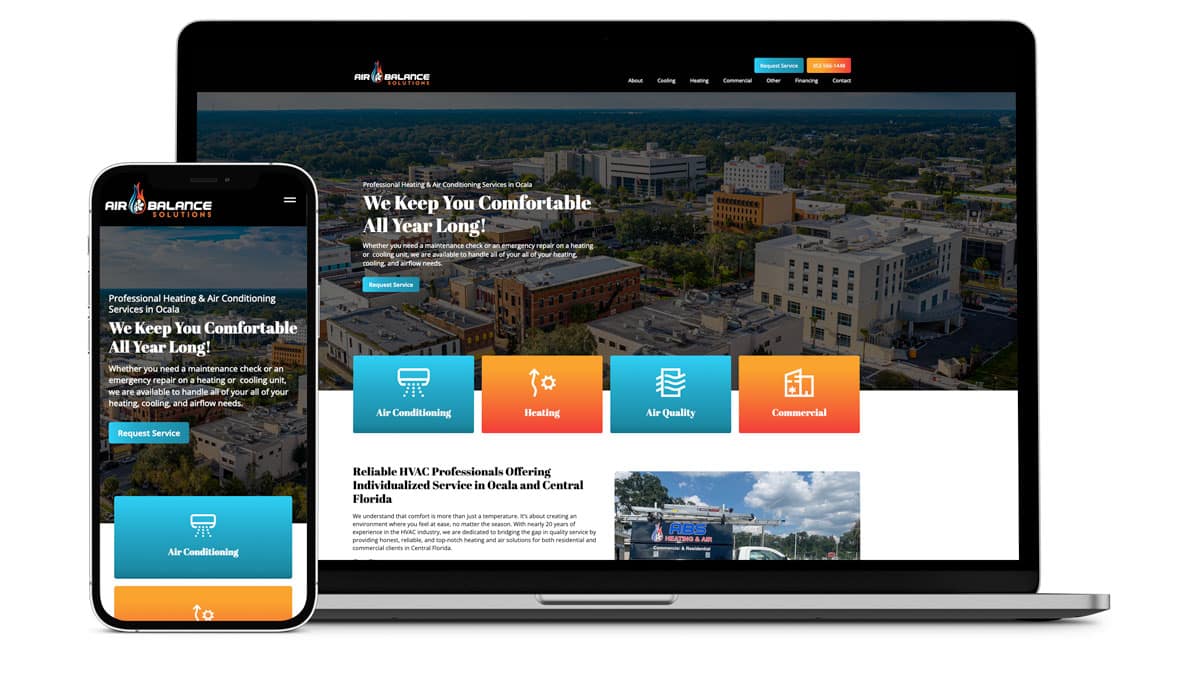In 2025, having a modern, well-designed website is more important than ever for businesses to connect with their audiences and stay competitive. Web design continues to evolve, introducing new trends that enhance user experience, improve accessibility, and keep websites fresh and engaging.
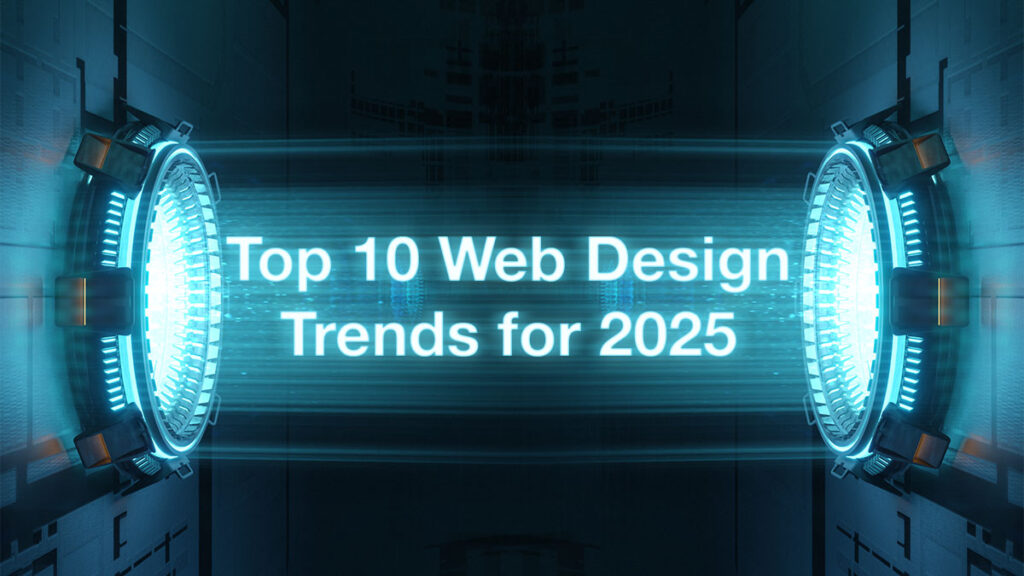
This article will dive into the top 10 web design trends of 2025. Whether you’re looking to refresh your current site or build a new one, understanding these trends can help your business stay ahead of the curve and deliver an exceptional online experience to your customers.
Key Takeaways
- First Impressions Matter: Modern web design trends, such as modular layouts and interactive animations, help create visually appealing websites that captivate visitors within seconds.
- User Experience Drives Success: Trends like dark mode, microinteractions, and advanced accessibility features enhance usability and make websites more engaging for all users.
- Staying Competitive is Essential: Incorporating cutting-edge innovations such as AI-driven personalization and 3D graphics ensures your website stands out from competitors and meets user expectations.
- Align Design with Business Goals: Not all trends suit every business. Focus on those that support your objectives and resonate with your audience for maximum impact.
- Adopt a Holistic Approach: Implementing new trends requires a mix of creativity, technical expertise, and continuous optimization. Regular updates and testing keep your site fresh and relevant.
By staying informed and embracing the right trends, your website can provide a better user experience, drive higher engagement, and reflect your brand’s commitment to innovation.
Why Web Design Trends Matter
Web design trends aren’t just about keeping up appearances—they’re about staying relevant in an ever-evolving digital landscape. As technology and user preferences change, websites must adapt to meet these new demands. Understanding why web design trends matter can help businesses make informed decisions about their online presence.
First Impressions Are Everything
Your website is often the first interaction a potential customer has with your brand. Studies show that it takes users just 0.05 seconds to form an opinion about your website. A modern, visually appealing site can create a positive first impression, while outdated designs may leave visitors unimpressed or distrustful of your brand.
User Experience Drives Engagement
Web design trends often focus on improving the user experience (UX). Features like faster loading times, responsive layouts, and intuitive navigation keep visitors engaged and encourage them to explore your site further. A well-designed website doesn’t just look good—it feels good to use.
Staying Competitive
With over 1.13 billion websites on the internet, standing out is a challenge. Adopting current design trends can help differentiate your site from competitors. Whether it’s through cutting-edge visuals or innovative features, staying on-trend can set your business apart and attract more visitors.
Boosting SEO and Performance
Search engines prioritize websites that deliver a great user experience. For example, Google’s Core Web Vitals metrics measure factors like page load speed, interactivity, and visual stability. Many web design trends focus on optimizing these metrics, which can help improve your search engine rankings and drive organic traffic.
Reflecting Your Brand’s Values
Design trends often align with broader societal shifts, like the growing emphasis on sustainability and accessibility. By incorporating trends such as eco-friendly hosting or inclusive design practices, you can demonstrate your brand’s commitment to values that resonate with modern consumers.
Why It Matters in 2025
User expectations are continually evolving. Incorporating modern design trends ensures your website remains relevant, performs well, and reflects your brand’s commitment to quality. Keeping up with these changes isn’t just beneficial—it’s essential for maintaining a competitive edge.
10 Web Design Innovations Shaping 2025
Web design trends in 2025 focus on enhancing user experience, improving accessibility, and leveraging innovative technology to create more engaging and efficient websites. Here are the top 10 trends shaping the digital landscape this year:
1. Modular and Grid-Based Design
Modular design uses pre-designed blocks or grids to create flexible and scalable layouts. This approach makes it easier to adapt websites to various screen sizes and ensures consistent branding.
- Why It’s Popular: Modular layouts save time in design and development while maintaining a polished and professional appearance.
- Example: News and content-heavy websites often use modular grids to display articles and multimedia in an organized way.
Bodhi Cycling is a great example of a modular, grid-based design.

2. Interactive Animations
Animations that respond to user actions, like hover effects or scroll-triggered movements, make websites more dynamic and engaging. These interactions add an element of surprise and keep users intrigued.
- Why It’s Popular: Interactive animations create memorable user experiences and guide attention to key elements on a page.
- Example: E-commerce sites use animations to highlight product features or display special offers.
Apple’s new iPad Pro landing page uses animation that guides perception and comprehension, such as information fading in and out as it is needed so you’re never overwhelmed with content.

3. Voice User Interfaces (VUI)
With the increasing use of smart speakers and voice search, integrating voice capabilities into websites is becoming more common. VUI allows users to interact with a site using spoken commands.
- Why It’s Popular: Voice interfaces make websites more accessible and offer hands-free navigation.
- Example: Service-based businesses can use VUI to help users book appointments or find answers to FAQs quickly.
4. Dark Mode and High-Contrast Design
Dark mode options are no longer just a feature—they’re an expectation. Paired with high-contrast elements, dark mode improves readability and offers a sleek aesthetic.
- Why It’s Popular: Dark mode reduces eye strain, especially in low-light environments, and gives websites a modern look.
- Example: Tech companies and creative agencies often adopt dark mode for their websites.
Masterclass is a great example of a dark mode website.
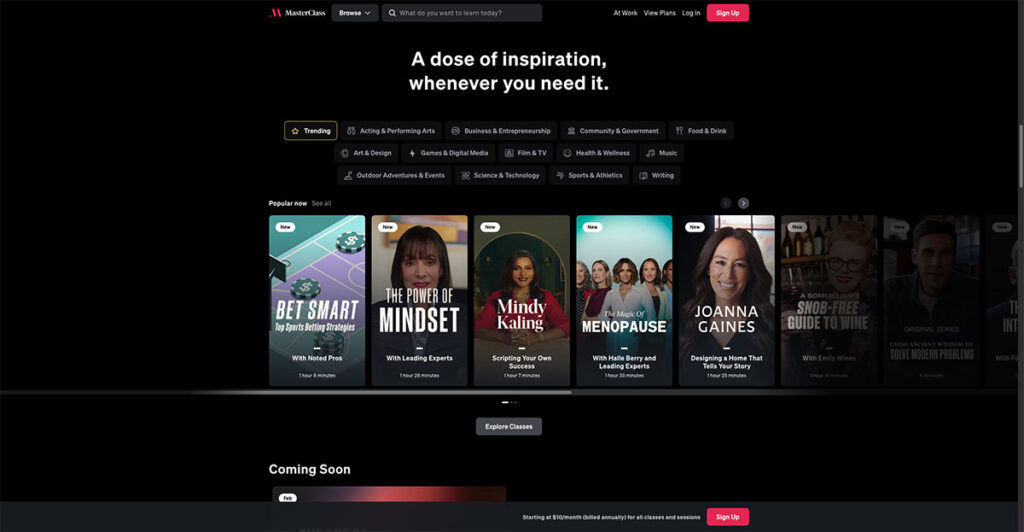
5. AI-Driven Personalization
Artificial intelligence allows websites to adapt content based on user behavior, preferences, or demographics. This creates a tailored experience for each visitor.
- Why It’s Popular: Personalization increases user satisfaction and engagement by delivering relevant content.
- Example: Retail websites recommend products based on browsing history and past purchases.
Syos displays a popup with a quiz to assist customers in finding the right product.
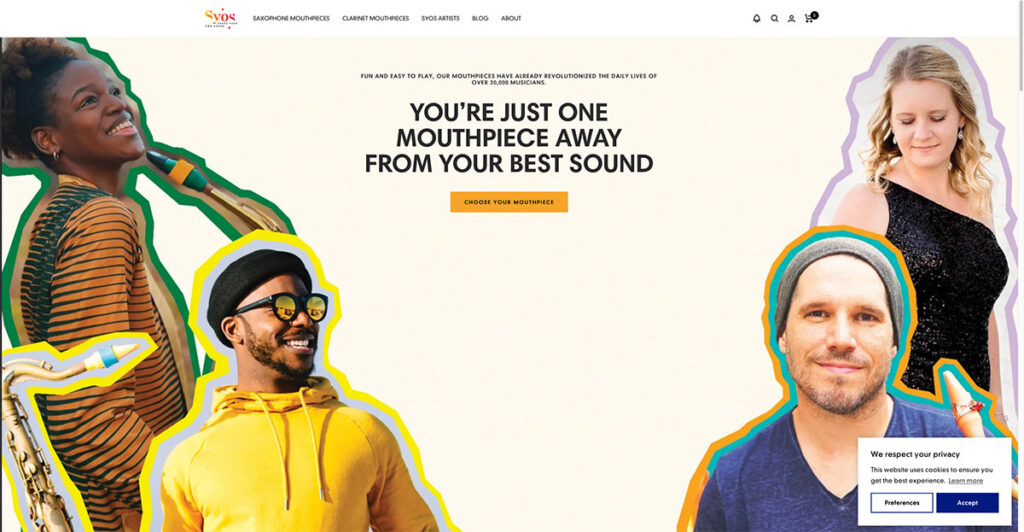
6. 3D Graphics and Immersive Experiences
Advancements in web technology now make it easier to include 3D graphics and animations. These elements provide depth and realism, creating a more immersive browsing experience.
- Why It’s Popular: 3D design captures attention and enhances storytelling.
- Example: Real estate websites use 3D tours to showcase properties interactively.
This site has been created by The Blue Marine Foundation, an organisation that’s dedicated to restoring ocean health by combating overfishing.
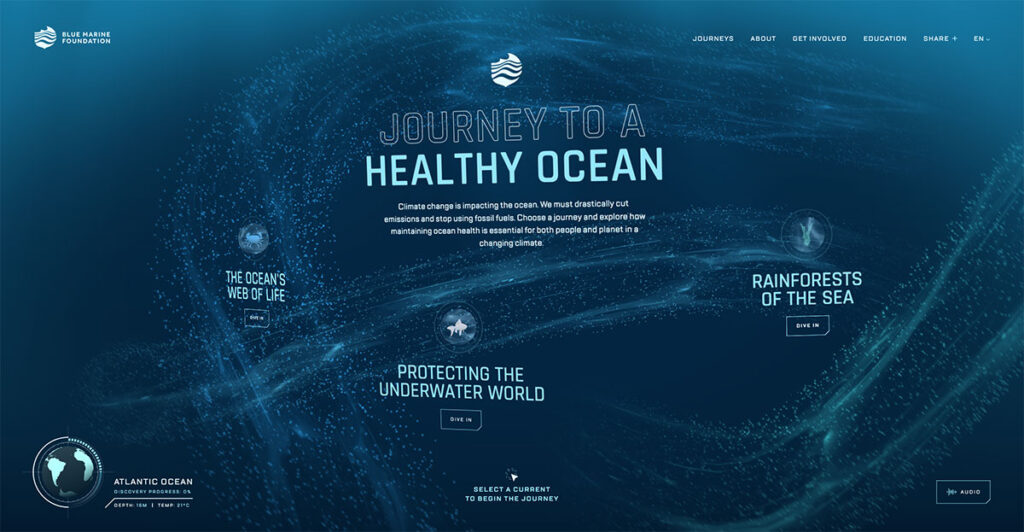
7. Sustainable Web Design
Sustainability is becoming a key consideration in web design. Practices like reducing code bloat, optimizing images, and using green hosting services minimize a website’s environmental footprint.
- Why It’s Popular: Eco-friendly websites align with growing consumer awareness of environmental issues.
- Example: Companies committed to sustainability highlight their green initiatives through lightweight, energy-efficient web designs.
8. Asymmetrical Layouts
Asymmetrical designs break away from traditional grid layouts to create visually dynamic and unique web pages. These layouts allow designers to experiment with creativity while maintaining balance.
- Why It’s Popular: Asymmetry adds personality and makes websites stand out.
- Example: Portfolio websites for artists and designers frequently use asymmetrical layouts.
9. Microinteractions
Small animations or effects, like buttons that change color on hover or a subtle vibration after a click, enhance the user experience without overwhelming the design.
- Why It’s Popular: Microinteractions provide immediate feedback, making websites feel responsive and user-friendly.
- Example: Social media platforms use microinteractions to acknowledge likes or shares.
The Porsche Car Configurator is an online tool that lets you build your perfect Porsche – including style, colour, wheel types and more.
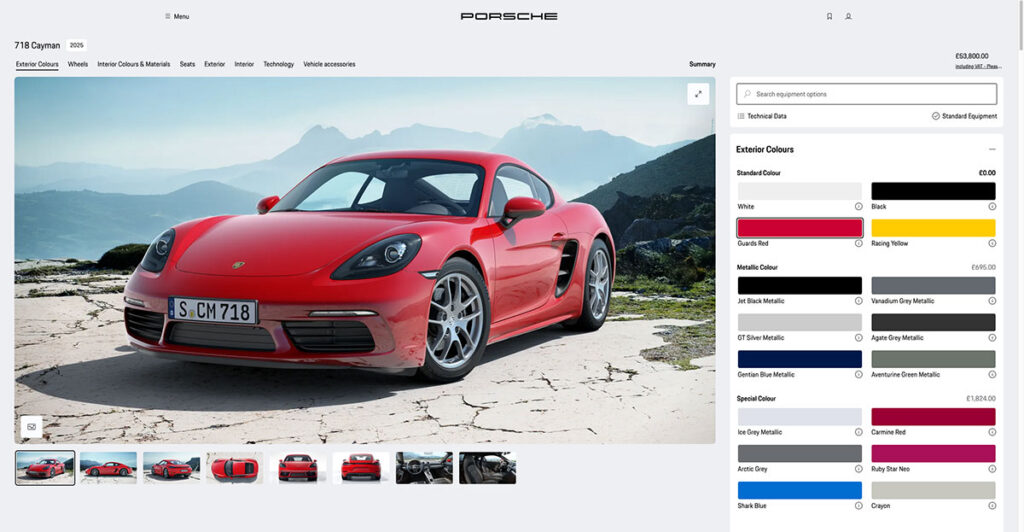
10. Advanced Accessibility Features
Web accessibility is evolving with features like voice navigation, text-to-speech, and improved keyboard navigation. These advancements ensure that websites are usable for everyone.
- Why It’s Popular: Prioritizing accessibility expands your audience and demonstrates inclusivity.
- Example: Nonprofit and government websites are leading the way in adopting advanced accessibility practices.
How to Adopt These Trends
Adopting the latest web design innovations requires careful planning and execution to ensure they align with your brand’s goals and audience expectations. Here are actionable steps for implementing these trends:
Evaluate Your Current Website
- Conduct a website audit to identify areas that need improvement, such as outdated layouts, slow loading times, or lack of accessibility.
- Use tools like Google PageSpeed Insights or Lighthouse to analyze performance and user experience metrics.
Prioritize Trends That Align With Your Goals
- Not all trends will suit every business. Identify which innovations, such as voice user interfaces or modular designs, support your specific objectives.
- For example, an e-commerce business might prioritize interactive animations to showcase products, while a nonprofit might focus on advanced accessibility features.
Partner with a Professional Web Design Team
- Working with experienced designers and developers ensures your website integrates these trends effectively.
- A professional team can help with complex implementations, like 3D graphics or AI-driven personalization, and ensure your site remains functional and user-friendly.
Test New Features Thoroughly
- Before fully launching any updates, test them with real users to gather feedback.
- Use A/B testing to compare new features with existing ones and refine them based on user behavior.
Stay Agile and Open to Iteration
- Web design is an ongoing process. Regularly update your site to incorporate feedback, address new challenges, and integrate future trends.
- Set a schedule for periodic updates to keep your website fresh and engaging.
Focus on Accessibility and Inclusivity
- Make accessibility a priority by following guidelines like the Web Content Accessibility Guidelines (WCAG).
- Test your site with accessibility tools to ensure it’s usable for individuals with disabilities.
Optimize for SEO
- Ensure new design elements, such as animations or 3D graphics, don’t negatively impact your site’s loading speed or search rankings.
- Compress media files, use lazy loading, and optimize code to maintain performance.
By taking these steps, businesses can integrate the latest web design trends seamlessly, ensuring their websites remain innovative, user-friendly, and competitive.
Conclusion
Web design in 2025 focuses on creating meaningful, engaging, and user-friendly experiences. By embracing trends like modular design, AI-driven personalization, and sustainable practices, your website can do more than just look good—it can become a powerful tool for driving growth and building stronger connections with your audience.
Adopting these innovations doesn’t have to be overwhelming. With careful planning and the right expertise, you can integrate the trends that best align with your business goals. Whether it’s incorporating 3D graphics, enhancing accessibility, or optimizing for voice search, each update can help your website stand out and provide value to your visitors.
If you’re ready to transform your website and explore these trends, partnering with a professional web design team can make all the difference. Reach out today to discuss how we can help bring your vision to life.

